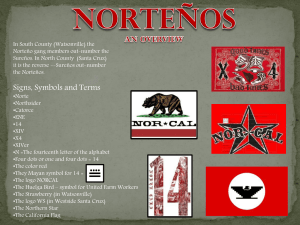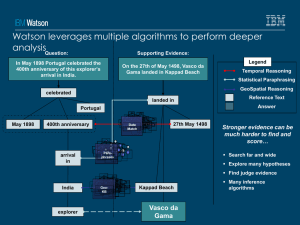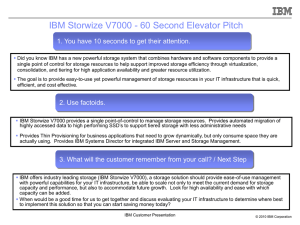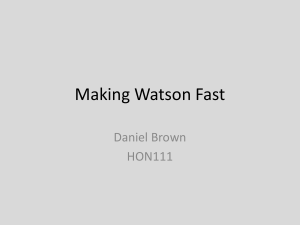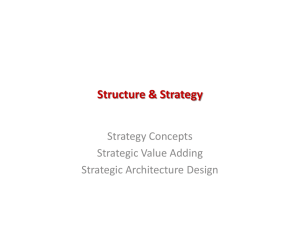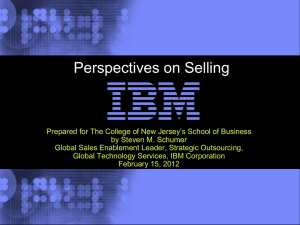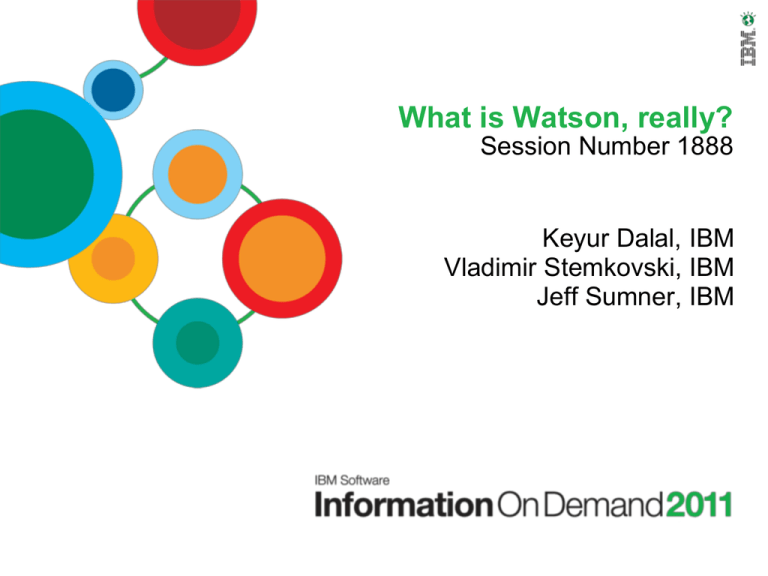
What is Watson, really?
Session Number 1888
Keyur Dalal, IBM
Vladimir Stemkovski, IBM
Jeff Sumner, IBM
Please note:
IBM’s statements regarding its plans, directions, and intent are subject to
change or withdrawal without notice at IBM’s sole discretion.
Information regarding potential future products is intended to outline our
general product direction and it should not be relied on in making a
purchasing decision.
The information mentioned regarding potential future products is not a
commitment, promise, or legal obligation to deliver any material, code or
functionality. Information about potential future products may not be
incorporated into any contract. The development, release, and timing of any
future features or functionality described for our products remains at our
sole discretion.
Performance is based on measurements and projections using standard
IBM benchmarks in a controlled environment. The actual throughput or
performance that any user will experience will vary depending upon many
factors, including considerations such as the amount of multiprogramming
in the user's job stream, the I/O configuration, the storage configuration,
and the workload processed. Therefore, no assurance can be given that an
individual user will achieve results similar to those stated here.
1
Acknowledgements and disclaimers:
Availability. References in this presentation to IBM products, programs, or services do not imply that they will be available in all
countries in which IBM operates.
The workshops, sessions and materials have been prepared by IBM or the session speakers and reflect their own views. They are
provided for informational purposes only, and are neither intended to, nor shall have the effect of being, legal or other guidance or advice
to any participant. While efforts were made to verify the completeness and accuracy of the information contained in this presentation, it is
provided AS-IS without warranty of any kind, express or implied. IBM shall not be responsible for any damages arising out of the use of,
or otherwise related to, this presentation or any other materials. Nothing contained in this presentation is intended to, nor shall have the
effect of, creating any warranties or representations from IBM or its suppliers or licensors, or altering the terms and conditions of the
applicable license agreement governing the use of IBM software.
All customer examples described are presented as illustrations of how those customers have used IBM products and the results they may
have achieved. Actual environmental costs and performance characteristics may vary by customer. Nothing contained in these
materials is intended to, nor shall have the effect of, stating or implying that any activities undertaken by you will result in any specific
sales, revenue growth or other results.
© Copyright IBM Corporation 2011. All rights reserved.
–
U.S. Government Users Restricted Rights - Use, duplication or disclosure restricted by GSA ADP Schedule Contract
with IBM Corp.
IBM, the IBM logo, ibm.com, and jStart are trademarks or registered trademarks of International Business Machines Corporation in the
United States, other countries, or both. If these and other IBM trademarked terms are marked on their first occurrence in this information
with a trademark symbol (® or ™), these symbols indicate U.S. registered or common law trademarks owned by IBM at the time this
information was published. Such trademarks may also be registered or common law trademarks in other countries. A current list of IBM
trademarks is available on the Web at “Copyright and trademark information” at www.ibm.com/legal/copytrade.shtml. Other company,
product, or service names may be trademarks or service marks of others.
2
What we’ll be discussing today...
• Introducing the jStart® Team
• What is IBM Watson?
– How Watson Got Started
– Where We Stand Today
• Watson: A Deep Dive
–
–
–
–
Watson’s Architecture
What components make up Watson
What Watson can do, today.
The Future of Watson
• How do we get started?
– Existing IBM technologies
– Examples of our work
• Q&A
3
Introducing IBM jStart®: Who we are & what we do
jStart is IBM’s emerging technologies client engagement team. Focused
on creating solutions built on the latest technologies, the team has been
working with companies since 1997 to address their business
challenges while providing business value, today. jStart’s latest initiative
is the commercialization of IBM’s Watson system.
Your presenters for today:
Keyur Dalal
IT Architect,
Managing
Consultant
4
Vladimir Stemkovski
IT Architect,
Managing
Consultant
Jeff Sumner
Product Marketing,
IBM Content
Analytics
What we’ll be discussing today...
• Introducing the jStart® Team
• What is IBM Watson?
– How Watson Got Started
– Where We Stand Today
• Watson: A Deep Dive
–
–
–
–
Watson’s Architecture
What components make up Watson
What Watson can do, today.
The Future of Watson
• How do we get started?
– Existing IBM technologies
– Examples of our work
• Q&A
5
IBM’s Grand Challenges
• IBM has a long history of “Grand Challenges”—in fact it’s been
doing grand challenges for the past century
• Why do them? To push science (and the company) in ways that
weren’t thought possible before.
“We look at areas where there's an enormous gap in current capability
and use that as a challenge. We call them Grand Challenges.”
- Dr. John E. Kelly III
Senior Vice President and Director of IBM
• What prompted IBM to consider the grand challenge that lead to
Watson? IBM was asking itself: “can a system be designed that
applies advanced data management and analytics to natural
language in order to uncover a single, reliable insight — in a fraction
of a second?”
6
The Challenge: Automatic Open-Domain Question Answering
A Long-Standing Challenge in Artificial Intelligence to emulate human expertise
• Given
– Rich Natural Language Questions
– Over a Broad Domain of Knowledge
• Deliver
– Precise Answers: Determine what is being asked & give precise
response
– Accurate Confidences: Determine likelihood answer is correct
– Consumable Justifications: Explain why the answer is right
– Fast Response Time: Precision & Confidence in <3 seconds
7
You may have heard of IBM’s Watson…
A. What is the computer
system that played
against human
opponents on
“Jeopardy”…
and won.
Why Jeopardy?
The game of Jeopardy! makes great demands on its players – from the range of topical
knowledge covered to the nuances in language employed in the clues. The question IBM
had for itself was “is it possible to build a computer system that could process big data and
come up with sensible answers in seconds—so well that it could compete with human
opponents?”
8
What exactly makes up Watson?
• A workload optimized system
•
•
•
•
•
•
•
•
•
•
•
•
1
9
90 x IBM Power 7501 servers
2880 POWER7 cores
POWER7 3.55 GHz chip
500 GB per sec on-chip bandwidth
10 Gb Ethernet network
15 Terabytes of memory
20 Terabytes of disk, clustered
Can operate at 80 Teraflops
Runs IBM DeepQA software
Scales out with and searches vast amounts of unstructured
information with UIMA & Hadoop open source components
Linux provides a scalable, open platform, optimized
to exploit POWER7 performance
10 racks include servers, networking, shared disk system,
cluster controllers
Note that the Power 750 featuring POWER7 is a commercially available
server that runs AIX, IBM i and Linux and has been in market since Feb 2010
What exactly makes up Watson?
• This means Watson…
• Operates at 80 teraflops. The
human brain is estimated to have a
processing power of 100 teraflops
(100 trillion operations per second).
• Has the equivalent in memory
(RAM) that the Library of Congress
adds in books and media over a 4
month period
• Can process 200 million times more
instructions per second than the
Space Shuttle’s computers.
• Parses within 3 seconds the
equivalent of the number of books
on a 700 yard long book shelf…and
pick out the relevant information,
and create an answer.
10
The Difference Between Search & DeepQA
Decision Maker
Has Question
Search Engine
Distills to 2-3 Keywords
Finds Documents containing Keywords
Reads Documents, Finds Answers
Delivers Documents based on Popularity
Finds & Analyzes Evidence
Expert
Decision Maker
Understands Question
Asks NL Question
Produces Possible Answers & Evidence
Considers Answer & Evidence
Analyzes Evidence, Computes Confidence
Delivers Response, Evidence & Confidence
11
What we’ll be discussing today...
• Introducing the jStart® Team
• What is IBM Watson?
– How Watson Got Started
– Where We Stand Today
• Watson: A Deep Dive
–
–
–
–
Watson’s Architecture
What components make up Watson
What Watson can do, today.
The Future of Watson
• How do we get started?
– Existing IBM technologies
– Examples of our work
• Q&A
12
DeepQA: the technology & architecture behind Watson
Learned Models
help combine and
weigh the Evidence
Evidence Sources
Answer Sources
Initial
Question
Question
& Topic
Analysis
13
Primary
Search
Question
Decomposition
Candidate
Answer
Generation
Hypothesis
Generation
Answer
Scoring
Evidence
Retrieval
Hypothesis
& Evidence
Scoring
Deep
Evidence
Scoring
Synthesis
Hypothesis
Generation
Hypothesis and
Evidence Scoring
Hypothesis
Generation
Hypothesis and Evidence
Scoring
model
model
model
model
model
model
model
model
model
Final Confidence
Merging & Ranking
Answer &
Confidence
DeepQA: the technology & architecture behind Watson
1
Initial
Question
Question
& Topic
Analysis
Initial Question Formulated:
“The name of this monetary
unit comes from the word for
"round"; earlier coins were
often oval”
3
Question
Decomposition
Watson performs
question analysis,
determines what is
being asked.
14
2
It decides whether
the question needs
to be subdivided.
DeepQA: the technology & architecture behind Watson
5
Answer Sources
Initial
Question
Question
& Topic
Analysis
Primary
Search
Question
Decomposition
Candidate
Answer
Generation
Hypothesis
Generation
Hypothesis
Generation
Hypothesis
Generation
15
In creating the
hypotheses it will
use, Watson consults
numerous sources
for potential
answers…
4
Watson then starts
to generate
hypotheses based
on decomposition
and initial
analysis…as many
hypothesis as may
be relevant to the
initial question…
DeepQA: the technology & architecture behind Watson
7
Evidence Sources
Answer Sources
Initial
Question
Question
& Topic
Analysis
Primary
Search
Question
Decomposition
6
16
Candidate
Answer
Generation
Hypothesis
Generation
Watson then uses
algorithms to
“score” each
potential answer and
assign a confidence
to that answer…
Answer
Scoring
Evidence
Retrieval
Hypothesis
& Evidence
Scoring
Deep
Evidence
Scoring
Synthesis
Hypothesis and
Evidence Scoring
Hypothesis and Evidence
Scoring
Watson uses
Evidence
Sources to
validate it’s
hypothesis and
help score the
potential
answers
If the question
was
decomposed,
Watson brings
together
hypotheses
from sub-parts
8
DeepQA: the technology & architecture behind Watson
9
Answer Sources
Initial
Question
Question
& Topic
Analysis
Primary
Search
Question
Decomposition
Candidate
Answer
Generation
Hypothesis
Generation
Hypothesis
Generation
Hypothesis
Generation
17
Using models
on the merged
hypotheses,
Watson can
weigh evidence
based on prior
“experiences”
Hypothesis
& Evidence
Scoring
Synthesis
Learned Models
help combine and
weigh the Evidence
model
model
model
model
model
model
model
model
model
Final Confidence
Merging & Ranking
10
Once Watson has
ranked its answers, it
then provides its
answers as well as the
confidence it has in
each answer.
Answer &
Confidence
DeepQA: the technology & architecture behind Watson
Learned Models
help combine and
weigh the Evidence
Evidence Sources
Answer Sources
Initial
Question
Question
& Topic
Analysis
18
Primary
Search
Question
Decomposition
Candidate
Answer
Generation
Hypothesis
Generation
Answer
Scoring
Evidence
Retrieval
Hypothesis
& Evidence
Scoring
Deep
Evidence
Scoring
Synthesis
Hypothesis
Generation
Hypothesis and
Evidence Scoring
Hypothesis
Generation
Hypothesis and Evidence
Scoring
model
model
model
model
model
model
model
model
model
Final Confidence
Merging & Ranking
Answer &
Confidence
Where did it acquire knowledge?
Three
types of
knowledge
•
•
•
•
•
•
•
•
•
•
19
Domain
Data
(articles, books,
documents)
Wikipedia
Time, Inc.
New York Time
Encarta
Oxford University
Internet Movie Database
IBM Dictionary
... J! Archive/YAGO/dbPedia…
Total Raw Content
Preprocessed Content
Training and test
question sets
w/answer keys
NLP Resources
(vocabularies,
taxonomies,
ontologies)
• 17 GB
• 2.0 GB
• 7.4 GB
• 0.3 GB
• 0.11 GB
• 0.1 GB
• 0.01 GB
XXX
• 70 GB
• 500 GB
How we convert data into knowledge for Watson’s use
Three
types of
knowledge
Domain
Data
(articles, books,
documents)
Training and test
question sets
w/answer keys
Converted to Indices for
search/passage lookup
Redirects extracted for
disambiguation
Frame cuts generated with
frequencies to determine likely
context
Pseudo docs extracted for
Candidate answer generation
20
Used to create logistic
regression model that
Watson uses for
merging scores
NLP Resources
(vocabularies,
taxonomies,
ontologies)
Named entity
detection,
relationship
detection algorithms
Custom slot
grammar parsers,
prolog rules for
semantic analysis
Machine learning
• One of the core components of the system
– Multiple models
– 14000+ training questions
• Every candidate answer gets hundreds of features/scores associated
with it. There features/scores are passed through previously trained
ML model for candidate answer scoring
• It’s not just one model. In fact there is a chain of models, each
subsequent one utilizes scores produced by previously run models
• Machine learning also used in other parts of the system, such as LAT
confidence analysis.
21
NLP
• Used in many places (Question Analysis, Evidence Analysis, Content
Pre-processing)
• Combines both rule and statistic based approaches
• Full NLP stack (used in QA)
–
–
–
–
–
–
Tokenization
Named Entity Recognition
Deep Parsing and Predicate Argument Structure creation
Lexical Answer Type (LAT) and Focus detection
Anaphora resolution
Semantic Relationships extraction
• Various technologies and techniques are used (English Slot Grammar
parser, R2 NED, machine learning for LAT confidence analysis,
custom annotators written in Prolog and Java)
22
NLP Examples
• LAT and Focus
– It's the Peter Benchley novel about a killer giant squid that
menaces the coast of Bermuda
• Named Entity Recognition
– It's the {Person::Peter Benchley} novel about a killer giant
{Animal::squid} that menaces the {Location::coast of
Bermuda}
• Anaphora Resolution
– Columbus embarked on his first voyage to this continent in
1492. In the next two decades he led three more expeditions
there.
23
NLP in evidence analysis and content pre-processing
• Why do NLP on evidence passages and ingested content?
• NLP in Evidence Analysis allows:
– LAT based scoring
– Named entities alignment based scoring
• NLP in Content Pre-processing
– Extracting and accumulating “knowledge” frames from the
content
• For instance
– SVO frame cuts will contain frequencies of Subject-Verb-Object
occurrences in the content that Watson has ingested.
– e.g squid menaces coast 809
– These “knowledge” frames are then used to generate candidate
answers
25
DeepQA: the technology & architecture behind Watson
Learned Models
help combine and
weigh the Evidence
Evidence Sources
Answer Sources
Initial
Question
Question
& Topic
Analysis
26
Primary
Search
Question
Decomposition
Candidate
Answer
Generation
Hypothesis
Generation
Answer
Scoring
Evidence
Retrieval
Hypothesis
& Evidence
Scoring
Deep
Evidence
Scoring
Synthesis
Hypothesis
Generation
Hypothesis and
Evidence Scoring
Hypothesis
Generation
Hypothesis and Evidence
Scoring
model
model
model
model
model
model
model
model
model
Final Confidence
Merging & Ranking
Answer &
Confidence
What is Watson good at?
27
What is Watson good at?
1
2
Questions
Asked
Answers
Watson
Training
Data
4
28
Data
Corpus
3
What is Watson good at?
Very broad range
Range
1
Wide range of
questions
Small set of FAQs
Questions
Asked
Type
What? Who?
How?
Yes/No?
When?
How many?
Why?
29
Predictive
vs Fact
Finding
Fact finding
Language
Used
English
Simple synthesis
Predictive/knowled
ge creation
Other
What is Watson good at?
High
Medium
Low
Low (mins/hours)
High (seconds)
One/few sufficient
All must be
returned
No
Yes
30
Need
understanding
of confidence
Response
time for
concurrent use
Multiple
correct
answers
Interactive
dialog
2
Answers
What is Watson good at?
Varied/largely
unstructured
Variety of
data
Mostly structured
Large
Small
Batch
Runtime
Size and
redundancy of
corpus
Rate of change
of underlying
data
Data
Corpus
3
31
What is Watson good at?
Large set of questions with
known answers
Training
Data
4
32
Little or no
training
data
Easy to generate
Hard to generate
What is Watson good at?
1
2
Questions
Asked
Answers
Watson
Training
Data
4
33
Data
Corpus
3
Watson enabled patient centered healthcare solutions
Care
Consideration
Analysis
Treatment
Protocol
Analysis
What’s New?
Consumer
Portal
Coding
Automation
Patient
Inquiry
Patient
Workup
Treatment
Authorization
Second
Opinion
Longitudinal
Patient Electronic
Health Information
Differential
Diagnosis
Treatment
Options
Specialty Diagnosis &
Treatment Options
Caregiver Education
Patient
34
Population
Analysis &
Care Mgmt
Lay Caregiver…PA… Nurse Practitioner
On-going
Treatment
Specialty
Research
Genomicbased Analysis
Physician
What we’ll be discussing today...
• Introducing the jStart® Team
• What is IBM Watson?
– How Watson Got Started
– Where We Stand Today
– The Future of Watson
• Watson: A Deep Dive
– Watson’s Architecture
– What components make up Watson
– What Watson can do, today.
• How do we get started?
– Existing IBM technologies
– Examples of our work
• Q&A
35
IBM Content Analytics is a platform to derive rapid
insight
• Transform raw information into
business insight quickly without
building models or deploying
complex systems.
• Derive insight in hours or days …
not weeks or months.
• Easy to use for all knowledge
workers to search and explore
content.
• Flexible and extensible for deeper
insights.
Rapidly Derived
Insight
Search
and Explore
Analyze
and Visualize
Aggregate
and Extract
External and Internal Content (and Data) Sources
including Social Media and More
36
IBM Content Analytics – highlights
• Dynamically search, analyze and
explore content for new business
insight
• Integrate analytics results into
other systems and applications
• Powerful content modeling with
support for advanced classification
delivering business specific
deeper insight
• Quickly generate Cognos BI
reports
IBM Content Analytics adds value to …
38
Healthcare Analytics
Customer Care
• Analyzing: E-Medical records, hospital reports
• For: Clinical analysis; treatment protocol
optimization
• Benefits: Better management of chronic
diseases; optimized drug formularies; improved
patient outcomes
• Analyzing: Call center logs, emails, online media
• For: Buyer Behavior, Churn prediction
• Benefits: Improve Customer satisfaction and
retention, marketing campaigns, find new
revenue opportunities
Crime Analytics
Insurance Fraud
• Analyzing: Case files, police records, 911 calls…
• For: Rapid crime solving & crime trend analysis
• Benefits: Safer communities & optimized force
deployment
• Analyzing: Insurance claims
• For: Detecting Fraudulent activity & patterns
• Benefits: Reduced losses, faster detection,
more efficient claims processes
Automotive Quality Insight
Social Media for Marketing
• Analyzing: Tech notes, call logs, online media
• For: Warranty Analysis, Quality Assurance
• Benefits: Reduce warranty costs, improve
customer satisfaction, marketing campaigns
• Analyzing: Call center notes, SharePoint,
multiple content repositories
• For: churn prediction, product/brand quality
• Benefits: Improve consumer satisfaction,
marketing campaigns, find new revenue
opportunities or product/brand quality issues
IBM SPSS Portfolio and Key Focus Areas
Real world ICA customer use cases
• Seton Healthcare: reducing CHF re-admission with advanced content
analytics and predictive modeling.
• Veteris: Clinical Trials Researcher
Profile Automation POC
• NC State University: discovering emerging trends and patterns
• USC – Annenberg School of Journalism: leveraging social media for
predicting performance
40
Smarter is: reducing CHF re-admission with advanced
content analytics and predictive modeling
Seton Healthcare
The Need:
Seton Healthcare strives to reduce the
occurrence of high cost CHF readmissions
by proactively identifying patients likely to be
readmitted on an emergent basis.
The Solution:
IBM will assist Seton to apply content and predictive analytics capabilities to better target and
understand high-risk CHF patients for care management programs by:
•Utilizing natural language processing to extract key elements from unstructured History and Physical, Discharge
Summaries, Echocardiogram Reports, and Consult Notes
•Leveraging predictive models that have demonstrated high positive predictive value against extracted elements of
structured and unstructured data (relative to null and prior cost models)
•Providing an interface through which knowledge workers can intuitively navigate, interpret and take action on this
connected, actionable patient data which previously spanned disparate systems
41
IBM content and predictive analytics for healthcare
IBM Content and Predictive Insights for Healthcare
Raw
Information
Predictive Analytics
Content Analytics
Unstructured Data
(Nurses Notes,
Discharge Notes, etc.)
Dynamic
Multimode
Interaction
Natural
Language
Processing
Predictive
Scoring and
Probability
Analysis
Medical
Terminology
Translation
Search and
Explore (Mine)
Analyzed Information
Structured Data
(Billing Data, EMR,
etc.)
* Future optional
capability
** Current
optional capability
42
Trend, Pattern,
Anomaly, Deviation
Detection and Analysis
Watson for Healthcare*
Deep Question
Answer from
Knowledge
Sources
Health Integration Framework
Data
Warehouse**
Master Data
Mgt**
Advanced
Case Mgt**
Business
Intelligence**
Other
Smart is: Identifying Clinical Researcher
Clinical Trials Researcher Profile Automation POC
Utilize IBM’s text analytics
technology to create and maintain
research profiles from unstructured
public data sources.
Use Cases
1. Create profile for researchers based on name search in public databases from
unstructured data.
2. Search for new or related names and profiles based on specific profile
descriptors, i.e. oncology + next gen sequencing
43
Smart is: discovering emerging trends and patterns
NC State University Research Patents Suitor Identification
Utilize IBM’s text analytics technology to help
NC State’s Office of Technology Transfer
identify companies that would be good
candidates to license NCSU innovations
•Discovery of individuals in those companies
•Discovery of contact information of those
individuals
Use Cases
1. Smart Inhaler technology
Crawl a series of pharma and pharma oriented web sites to find potential licensees of a smart
inhaler NCSU has developed where targeted drug deposition is achieved by injecting the drug
aerosols from an optimal release position in the mouth inlet cross section by means of a
controllable nozzle
Look for evidence of failed inhaler oriented clinical trials, mine company names and contact info
2. New Husbandry Vaccine
Crawl a series of pharma and pharma oriented web sites to find potential licensees for a new strain
of Salmonella enterica serovar Typhimurium NCSU has developed
Look for evidence of vaccine related R&D, involving animals (not humans), mine company names
and contact info
44
Smart is: leveraging social media for predicting performance
USC Annenberg School for Communication and Journalism
Leveraging the “new water cooler”
Social Media Sentiment Analysis with
IBM BigSheets and IBM Content
Analytics.
Use Cases
1.
Film forecaster: A Twitter Box Office Predictor
Captures twitter and analyze volume of tweets mentioning upcoming movies and gauges their
sentiment.
• Analyzed more than 1 million movie-related tweets shows the premiere of "Harry Potter"
as the star of Twitter movie chatter. It was the subject of nearly 53 percent of the tweets
that expressed sentiment.
• In May, the tool correctly predicted a clamor for "Hangover 2" that resulted in a $100
million opening over Memorial Day weekend.
2.
45
Work Underway
•
Summers Arab Revolutions Analysis
•
Republican Candidate Nomination
What we’ll be discussing today...
• Introducing the jStart® Team
• What is IBM Watson?
– How Watson Got Started
– Where We Stand Today
– The Future of Watson
• Watson: A Deep Dive
– Watson’s Architecture
– What components make up Watson
– What Watson can do, today.
• How do we get started?
– Existing IBM technologies
– Examples of our work
• Q&A
46
Communities
• On-line communities, User Groups, Technical Forums, Blogs,
Social networks, and more
– Find the community that interests you…
• Information Management ibm.com/software/data/community
• Business Analytics ibm.com/software/analytics/community
• Enterprise Content Management ibm.com/software/data/contentmanagement/usernet.html
• IBM Champions
– Recognizing individuals who have made the most outstanding
contributions to Information Management, Business Analytics, and
Enterprise Content Management communities
• ibm.com/champion
Thank You!
Your Feedback is Important to Us
• Access your personal session survey list and complete via SmartSite
– Your smart phone or web browser at: iodsmartsite.com
– Any SmartSite kiosk onsite
– Each completed session survey increases your chance to win
an Apple iPod Touch with daily drawing sponsored by Alliance
Tech
48
Backup Slides
49
Sample questions
This fish was thought to be extinct millions of years ago
until one was found off South Africa in 1938.
Category: ENDS IN "TH"
Answer:
When hit by electrons, a phosphor gives off electromagnetic energy in this
form.
Category: General Science
Answer:
Secretary Chase just submitted this to me for the third time--guess what,
pal. This time I'm accepting it.
Category: Lincoln Blogs
Answer: His resignation
50
Glossary
•
•
•
•
•
UIMA – Unstructured Information Management Architecture
LAT – Lexical Answer Type i.e. fish, thing, person
NLP – Natural Language Processing
ESG – English Slot Grammar
NED/NER – Named Entity Detection/Named Entity Recognition

